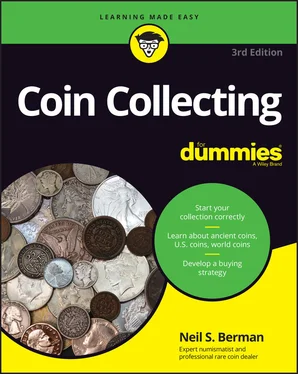Neil S. Berman - Coin Collecting For Dummies
Здесь есть возможность читать онлайн «Neil S. Berman - Coin Collecting For Dummies» — ознакомительный отрывок электронной книги совершенно бесплатно, а после прочтения отрывка купить полную версию. В некоторых случаях можно слушать аудио, скачать через торрент в формате fb2 и присутствует краткое содержание. Жанр: unrecognised, на английском языке. Описание произведения, (предисловие) а так же отзывы посетителей доступны на портале библиотеки ЛибКат.
- Название:Coin Collecting For Dummies
- Автор:
- Жанр:
- Год:неизвестен
- ISBN:нет данных
- Рейтинг книги:4 / 5. Голосов: 1
-
Избранное:Добавить в избранное
- Отзывы:
-
Ваша оценка:
- 80
- 1
- 2
- 3
- 4
- 5
Coin Collecting For Dummies: краткое содержание, описание и аннотация
Предлагаем к чтению аннотацию, описание, краткое содержание или предисловие (зависит от того, что написал сам автор книги «Coin Collecting For Dummies»). Если вы не нашли необходимую информацию о книге — напишите в комментариях, мы постараемся отыскать её.
Coin Collecting For Dummies,
numismatics
Coin Collecting For Dummies
Coin Collecting For Dummies — читать онлайн ознакомительный отрывок
Ниже представлен текст книги, разбитый по страницам. Система сохранения места последней прочитанной страницы, позволяет с удобством читать онлайн бесплатно книгу «Coin Collecting For Dummies», без необходимости каждый раз заново искать на чём Вы остановились. Поставьте закладку, и сможете в любой момент перейти на страницу, на которой закончили чтение.
Интервал:
Закладка:
Transaction costs are part of numismatics, but not in such an obvious way. In numismatics, transaction costs are baked into the buy/sell spreads (the difference between what a dealer pays for a coin and how much they sell the coin for). Buy/sell spreads are much wider than they are in stocks. The buy/sell spread on a $100 stock may be 50¢, for example, but on a $100 coin, the spread may be as wide as $30. Suppose that you buy a coin for $100. Ask the dealer what they’d pay to buy the coin back in a week. If the buyback price is $90, you’re facing a potential loss of $10. Therefore, the market has to go up $10 just for you to break even on the coin.
 Every time you buy a coin that isn’t part of your collecting plan, you face unnecessary transaction costs — one more reason not to buy any unplanned coins.
Every time you buy a coin that isn’t part of your collecting plan, you face unnecessary transaction costs — one more reason not to buy any unplanned coins.
Thinking long-term
Most big-name coin collections were formed over a long period by people who had a clear vision of what they wanted to accomplish. By approaching coin collecting with the same attitude, you can make your experience with coin collecting just as enjoyable and successful as anyone else’s.
Two areas are of primary importance when you’re developing your long-term view: price trends and opportunities. If nothing else, these two areas offer hope for the collector who may otherwise decide that finding certain coins is impossible. Patience may be its own reward, but a long-term view in coin collecting can make or save you money and open opportunities that are most certainly real and possible.
Long-term price trends
Looking back at the history of coin collecting, you’ll see a general upward trend in coin prices. Just like everything else in the world, coins cost more today than they did 50 years ago. Down the road, you can expect higher prices, but you can’t bet on them.
 As you set your collecting goals, plan for future price increases, and determine whether you can afford to finish what you’ve started. Keep in mind that there may be some wild swings along the way — hot markets, in which the coins you seek seem to be out of reach, followed by cool markets, in which the coins you collect seem like bargains.
As you set your collecting goals, plan for future price increases, and determine whether you can afford to finish what you’ve started. Keep in mind that there may be some wild swings along the way — hot markets, in which the coins you seek seem to be out of reach, followed by cool markets, in which the coins you collect seem like bargains.
Long-term opportunities
The longer you’re active in collecting, the better your chances are of acquiring the rare coins you need. Sometimes, the opportunity to purchase a coin is rarer than the coin itself, so you must be patient and ready to pounce when your coin finally appears. Never assume that a coin is locked away forever. Who ever thought that Johns Hopkins University would sell off the Garrett collection? Who suspected that I’d ever have a chance to bid on coins from Byron Reed’s collection or from the Joseph C. Mitchelson collection, or more recently, the fabulous D. Brent Pogue Collection in 2016? I simply don’t know what neat collections lurk around the corner. But the fact that strong hands have sold their coins in the past gives me hope that others will do the same in the future.
Chapter 4
Storing Your Collection Correctly
IN THIS CHAPTER
 Displaying your collection
Displaying your collection
 Handling and cleaning your coins
Handling and cleaning your coins
 Avoiding moisture
Avoiding moisture
 Securing and insuring your collection
Securing and insuring your collection
Assuming that it stays in circulation, an average coin lasts roughly 30 years during a regular journey from the time it’s minted to the day it wears out completely. Check the change in your pocket to see how much money you have dated before 1970. You likely won’t find very many coins, if any. Over the years, coins are damaged, lost, worn out, burned up, corroded, or dirtied, or they wind up in piggy banks and coin collections.
Given proper protection, a coin may last forever under perfect conditions. So although you may think you own the coins in your collection, you’re really just taking care of them for the next owner. By protecting your coins today, you benefit from the preservation of their value for yourself and future generations, just as you’ve benefited from the efforts of the collectors who came before.
The three most important things you can do to preserve your coins are
Protect them.
Keep them safe.
Keep them dry.
In this chapter, I show you how.
Holdering Them the Right Way
Choosing the right holder is an important first step in your collecting plan, because the cost of holders can be quite high, especially if your collection becomes large. Many types of holders and accessories are available for protecting, storing, and displaying your collection. Some holders are meant only for short-term storage and may actually harm your coins over long periods. Surprisingly, I’ve learned that some holders — the very ones that are supposed to protect your coins — are made with chemicals that attack and damage them. Other holdersare perfect for long-term storage and careful preservation of your numismatic treasures. Here are your options:
Cigar box (stogie storer): Inexpensive (unless you smoke high-priced stogies) and great for beginners, but lacks a certain level of sophistication and panache.
Paper envelopes: Traditional and inexpensive. A variety of sizes are available at your office-supplies store. Coin dealers sell small (2x2-inch) paper envelopes made for coin collectors (see Figure 4-1). You can write information about the coin on the outside of the envelope. Colors allow you to code your collection. Sulfur-free versions are excellent for long-term storage. The sulfur used to manufacture paper causes coins to tarnish, although today, most of the envelopes targeted to the coin market are sulfur-free. Another potential disadvantage of paper envelopes is that you can’t see the coin inside without opening the holder and disturbing the coin. FIGURE 4-1:Paper envelopes for storing coins.
Cardboard 2x2s: Inexpensive, starting out as 2x4-inch sheets of Mylar (clear plastic film) glued to card stock containing two holes of identical size (see Figure 4-2). The coin is placed on the Mylar, and then the holder is folded over and stapled together. Some cardboard 2x2s have a layer of adhesive that seals the holder and eliminates the need for staples. Coins are easily viewed through the Mylar windows. This option is excellent for long-term storage (except in areas of high humidity) as long as the Mylar film remains intact. If I had a dime for every coin destroyed by a staple, I could vacation in Bermuda for a week. Be careful when stapling the holder; make sure not to hit the coin. Also, be very careful when you staple the holder, and crimp the staples to make sure that they don’t damage the coins in other holders. Removing coins from cardboard 2x2s must also be done carefully so as not to scratch the coins. FIGURE 4-2:Cardboard 2x2s for storing coins.
Vinyl 2x2s: Inexpensive and great for handling and viewing coins. Also known as flips, these 2x4-inch holders have two pockets that fold over to a convenient 2x2-inch size (see Figure 4-3). One side holds your coin; the other is a card on which you can place a description. There are many online sites devoted to the preservation of coins. This method of storage is known widely as Saflips. There are a few optionsfor placement of your coins in these Saflips.I have a difficult time getting the harder flips to stand up in a row inside a box. The softer, vinyl flips don’t seem to have this problem. Excellent for short-term storage. Used by most dealers and auction houses as a convenient method of displaying, protecting, and shipping coins. FIGURE 4-3:Vinyl 2x2s for storing coins. Some vinyl flips are made with PVC, a chemical that can leach out over time and damage your coins. Therefore, this kind of holder can’t be used for long-term storage. Certain brands are made without PVC, but this causes them to become brittle and crack.
Читать дальшеИнтервал:
Закладка:
Похожие книги на «Coin Collecting For Dummies»
Представляем Вашему вниманию похожие книги на «Coin Collecting For Dummies» списком для выбора. Мы отобрали схожую по названию и смыслу литературу в надежде предоставить читателям больше вариантов отыскать новые, интересные, ещё непрочитанные произведения.
Обсуждение, отзывы о книге «Coin Collecting For Dummies» и просто собственные мнения читателей. Оставьте ваши комментарии, напишите, что Вы думаете о произведении, его смысле или главных героях. Укажите что конкретно понравилось, а что нет, и почему Вы так считаете.












